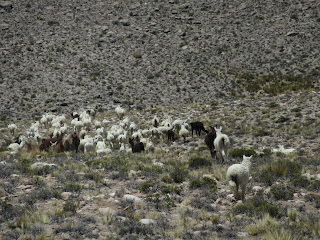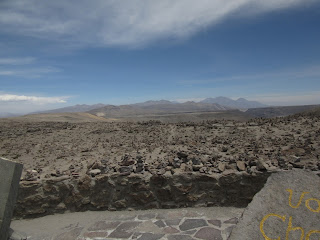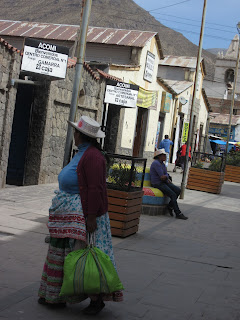Arequipa's bronze statue on the city's outskirts represented liberty.
Jimmy, the guide, explained that because we'd be reaching altitudes of close to 5,000 meters above sea level or masl - the equivalent of 16,400 feet - we were strongly advised to take necessary precautions to cope with the side effects of the high altitude. Therefore, we all trooped into the small shop on the outskirts of town to buy the recommended bags of coca leaves, a bottle of coca well - a drink to also ward off side effects - some dark chocolate bars and some OTC pills made from plants.
We were assured we would be weak and dizzy, etc if we didn't each buy all the products. I remember feeling this all seemed like a bit of a scam, wondering if the tour guides and/or the companies received a kickback from the one store who had a half dozen or so vans out front filled with tourists en route to the canyon. I didn't doubt that their guides too, had instructed their tourists to buy, buy, buy these remedies or otherwise suffer from the consequences.
There were so many flavors of coca to choose from: toffee, eucalyptus, honey, etc and, in other aisles, just plain coca leaves.
Note the image of a Inca man on the bottle of coca well!
Steven looked happy enough before he began chewing one of the coca leaves even though we were told it would make our lips and tongues feel numb.
I tried chewing quite a few of the leaves but found them distasteful to swallow and later figured, I would prefer to just deal with the side effects rather than chewing an entire bag of leaves, a whole bottle of the coca well, the pills, etc. I was glad we had stuck to our guns and only bought one bag of the leaves and the drink rather than one each!
Darlene: I couldn't help but think of you the length of the tour when our guide displayed his Sears shirt! There were five Peruvians and one English-speaking Frenchman on our tour and the guide went effortlessly back and forth between Spanish and English as he described everything.
A market as we climbed the hills out of Arequipa:
Once we were out in the country, we had a lovely view of almost 20,000 foot high Mt. Chachani, one of the three stupendous mountains that surrounded Arequipa.
Our guide stated that a mixture of cold water and hot springs were needed to grow potatoes, onions and garlic in the arid areas outside of the city at an elevation of over 10,000 feet.
As this settlement at 3,600 masl or almost 12,000 feet was located in the Salinas & Aguada Blanca National Reserve, all the animals in it were protected.
Since, just moments earlier we'd passed a sign that said Zona de Vicuñas, we weren't surprised to come across many vicuñas, one of two wild South American camelids which live in the high alpine areas of the Andes. Vicuñas produce small amounts of extremely fine wool, which is very expensive because the animal can only be shorn every three years, and has to be caught from the wild.
Located about 4,000 masl in the National Reserve at the foot of the Chachani peak, the large plain represented one of the best habitats for the protection of vicuñas.
The Inca valued vicuñas highly for their wool, and it was against the law for anyone but royalty to wear vicuña garments; today the vicuña is the national animal of Peru and appears in the Peruvian coat of arms.
Even though by then we had reached an elevation of 4,000 masl or over 13,000 feet, neither Steven or I felt the effects of the altitude, just the cold from the rapidly dropping temperatures and strong winds as we stood outside the van and watched the vicuñas as they walked so slowly on the flat ground.
The backdrop of the striking Pichu Pichu, Misti and Chachani mountains that we'd seen yesterday from Arequipa was beautiful.
Being able to see a few of the vicuñas up close was very special.
Ever since we began our overseas adventure trips five years ago, I have loved seeing and taking photos of, if possible, animal crossing signs. This was the first vicuña sign we'd seen!
Jimmy mentioned there were gold, silver and copper mines near this area called Patahuasi, a Quechua word for high roof.
Since leaving Arequipa, we'd been travelling on a busy highway that was popular for long haul truckers to and from the Sacred Valley city of Cusco and Puno, further south. It was as good as any back home in Colorado.
I think the other members of the group were as happy as we were when we stopped at the rest area and lookout which had a large number of local women selling crafts in addition to being able to buy snacks.
Steven bought himself a warm scarf which came in handy for a good part of the rest of the trip.
The views of the intriguing landscape from the rest area were striking.
These tourists with the Education with a Destination tour group were having their pulse oxygen levels checked during their rest stop. Our far less expensive tour didn't!
Another image of the rather spooky-looking coca well bottle that Jimmy encouraged us to take some more swigs of to fight the effects of the high altitude!
Jimmy explained that the name of this area was Sumbay; its principal characteristic was the gold, silver and copper in the surrounding mountains. Few people lived in the area because mining was no longer as prosperous.
A bit further on, we stopped again - this time to see llamas galore who were very close to the highway. We were spellbound by the beautiful animals, many of whom sported bright pink ribbons!
This shepherdess watched over her flock.
Jimmy told us this Puruña stone forest was formed by natural erosion.
This small cemetery belonged to the village of Picthuasi that we had just driven through.
A view of the magnificent Andes lay in front of us.
We continued to the Toccra wetlands, a mixture of swamps and fresh water. Jimmy thought we'd likely see some black birds with yellow beaks, ducklings, geese and even some flamingos who all made their homes in the wetlands.Sorry, Judy, we didn't see any flamingos after all as Jimmy had hoped - you'll just have to wait a bit longer before you'll see more than you ever wanted!
The crested ducks were lovely, however, in the peaceful wetlands located at 4,550 masl or almost 15,000 feet.
Only a few families lived in these areatas or pastoral areas, according to Jimmy, and they harvested alpaca fiber in the intense vegetation. It looked like it would be a very hard existence with unforgiving weather much of the year at such high altitudes.
It was amazing to think we were only a few hours from Arequipa, Peru's second largest city, and known as the city of sun with over 300 sunny days a year by comparison.
Jimmy stated this was Chucura Crater, a dead volcano.
After leaving the reserve, we had another opportunity a short while later to admire the beautiful views at the lookout for the gorgeous Volcan Ubinas, located at over 18,600 feet above sea level. Jimmy told us since this was the highest point of our trip at 4,900 masl or 16,076 feet, there would only be a ten-minute stop. He advised us to walk slowly and make sure to cover our heads because of the extreme altitude. If we felt sick to our stomach, we were to head back to the van right away. Luckily, we both felt okay and made every use of our limited time.
Despite the considerable 6,057 m height of Chachani, we learned snow is very scarce at its summit due to extreme atmospheric dryness on the western slope of the southern Andes. We were saddened to hear the summit lost its last remaining glacier in 2008 because of global warming.
Lots of people must have had considerable time to build all the cairns or rock balancing that seemed to go on forever!
All the tours must stop at the same lookouts as there were always locals selling handicrafts at each place. I was glad to support the women by buying a couple of scarves!
From that high point, we descended quickly into the Colca Valley that Jimmy said was rich in minerals with gold, silver and zinc present. That explained why we kept seeing different colored rocks all over the barren landscape. The Colca Valley was named after one of the survival skills of the ancient Colca people, namely the ability to store large amounts of grain for hard times in the warehouses, known as 'colcas'.
Another lovely viewpoint, this one of the Colca Valley ...
... meant, of course, more crafts to look at!
Jimmy explained that the silver hats and elaborate clothing worn by these women were typical of those worn in the nearby town of Chivay.
We didn't know it then, of course, but all the towns we saw in the Colca Valley had spectacular entrance gates like Chivay's.
Jimmy and the other six people on the tour stopped at a restaurant outside of town for lunch but Steven and I weren't interested in spending what we considered an exorbitant amount of money for what appeared to be inferior food. Instead, we decided to walk into the small town of Chivay and explore by ourselves and meet up with the others in an hour or so.The Plaza de Armas, the center of the town where the village church stood and tour buses gathered, had a pretty fountain and an attractive green space.
By the fountain was a pretty statue of two locals dancing.
By chance, we happened on a busy pedestrian street not far from the town square which contained a number of interesting statues similar to the one we'd just seen by the fountain.
The Qamile is a fertility dance to ensure good harvests.
The Negrillo statue represented the men from the coast who emigrated to Caylloma, the province where Chivay was located. During the dance, the men sing praises to the Virgin Asunta, the Lord of Chivay.
The Sara Tarpuy dance, performed before the corn harvest, was one of the agricultural dances and was the continuation of the Qamile planting dance.
I was glad I was able to take the picture of the local woman as she peered around the corner.We read that the Arriero character was one of the most historical as it was responsible for bringing in the products carried from the highlands on mules and llamas to the coast and then returned to barter the coast's seafood products.
What luck that we just happened to wander down the street and come across the statues as they were an interesting contribution to the folklore of the area.
When we travel, we're always drawn to markets, So, when we spotted this one just off the pedestrian street, we hurried over, knowing we only had a few more minutes before having to rush back through town to meet up with the other tour participants.
I can't stop smiling when I look at the photo of this woman in the market!
Almost all the women in Chivay sported silver-colored hats which were different from those we'd spotted everywhere else in Peru.
What a hoot seeing the Batman tuk tuk on our way back to the restaurant!
Jimmy said the group of buildings next to the restaurant was an orphanage called Casa Chapi, run by Americans.
Jimmy told us that people living near Chivay raise animals on a maximum of three hectares each, about seven acres. As the other tourists were staying in Chivay, they were dropped off at their hotel in town. Months ago, we had made our tour arrangements of the Colca Valley & Canyon with a lodge in nearby Yanque, not realizing until midday that Killawasi Lodge didn't actually provide the tour, only the accommodation.
It's impossible to see in this photo but there were a series of pipes to fertilize the terraced farms in the valley coming from nearby waterfalls.
Jimmy indicated there were twenty towns in the Colca Valley and that we'd be seeing more of them the next day as we toured the canyon.
Yanque's town square: I imagine it was also called Plaza Armas, just like every other town in Peru!
The Killawasi Lodge was beautiful but we only had a few minutes to enjoy our lovely room and balcony before going on a 2.5 hour guided hike with a hotel employee.
Next post: Private hike to Uyu Uyu pre-Inca ruins.
Posted on February 7th, 2018, from Littleton, Colorado.






















































































































No comments:
Post a Comment